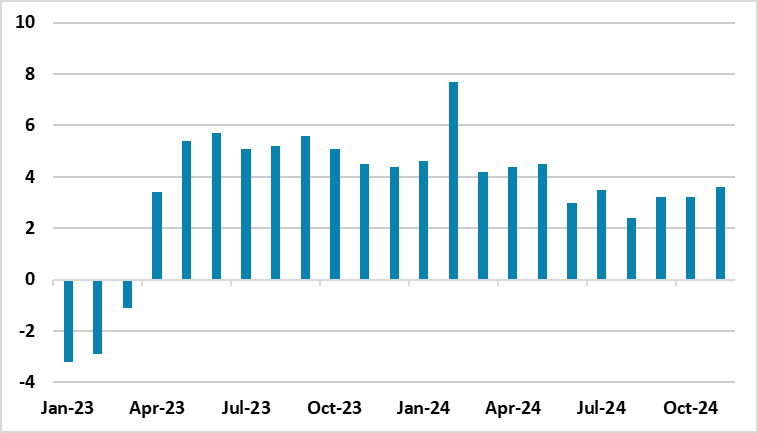Russian Economy Grew by 3.6% YoY in November
Bottom Line: According to the preliminary figures announced by the Ministry of Economic Development, Russia's GDP expanded by 3.6% YoY in November driven by strong military spending while monetary tightening, sanctions, and higher price pressures remain restrictive. We envisage growth to hit 1.6% and 1.5% in 2025 and 2026, respectively, which is less than 2024 figure, as we foresee a ceasefire in Ukraine in 2025, and then peace negotiations, which will likely lower Russia’s military spending and fiscal stimulus.
Figure 1: GDP Growth (%, Annual), January 2023 – November 2024

Source: Ministry of Economic Development
Russian economy continued its growth pattern in November, and grew by 3.6% YoY backed up by fiscal stimulus, strong military spending and investments. According to the announcement by the Ministry of Economic Development, the economy grew 4.0% YoY in January-November. Seasonally adjusted MoM growth stood at 0.0% in November after hitting 0.1% in October.
Russia's manufacturing sector activity expanded for the third straight month in December, though the pace of growth eased amid softer rises in output and new orders, survey results from S&P Global showed on December 27. The overall upturn was supported by further expansions in output and new orders while inflationary pressures remained high and business confidence slightly weakened. "Greater business with neighboring countries boosted new sales from abroad, which increased for a fifth month running," S&P Global report said.
Speaking about the GDP growth, President Putin told reporters on December 26 that growth in 2024 will be around 4%. According to Putin, the recent prints demonstrate that country's economic expansion will remain strong for some time. Deputy prime minister Alexander Novak also underscored on December 25 that Russia's GDP growth in 2025 may hit 2%-2.5% suggesting domestic economy continues to experience sustainable and dynamic development.
The main driver for the GDP growth remains the surge in military spending, supported by the improved consumer demand amid greater outlays on social support, higher wages and strong fiscal stimulus. There is an increased public spending in war-related industries and construction in Russia as public spending is at unprecedented levels as around 40% of the government budget is spent on the war.
We envisage growth to hit 1.6% and 1.5% in 2025 and 2026, respectively, which is significantly less than 2024 figure, as we foresee a ceasefire declared in Ukraine in 2025 and then peace negotiations, which are more likely during Trump’s second term and given Putin feels concessions can more easily won.